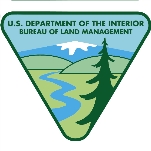Following World War II, the federal government decided a new authority was needed to better manage public lands. In 1946, the Grazing Service was merged with the General Land Office to form the Bureau of Land Management (BLM) within the Department of the Interior. At that time there were more than 2,000 laws for managing public lands, and BLM was left with no unified legislative mandate until Congress enacted the
Federal Land Policy and Management Act of 1976 (FLPMA)
(PDF). While the passage of FLPMA reaffirmed the importance of public ownership of federal lands, the act also established the term “multiple-use” management, which meant public lands would continue to be used for their economic benefits as well as valued for their intrinsic natural beauty.
- USGS-BLM Science Partnership
|
Claim Owner
|
# Claims
|
Acreage
|
|
Newmont Mining Corp (Denver, CO)
|
17,643
|
347,458
|
|
Placer Dome Inc (Canada)
|
13,766
|
268,758
|
|
Rio Tinto Limited (Australia)
|
10,097
|
191,928
|
|
Barrick Gold Corporation (Canada)
|
5,768
|
125,956
|
|
Phelps Dodge Mining Co (Phoenix, AZ)
|
7,105
|
124,297
|
|
Kinross (Canada)
|
4,306
|
98,853
|
|
Cameco Corp (Canada)
|
3,209
|
66,204
|
|
ASARCO, subsidiary of Grupo Mexico (Mexico)
|
3,187
|
61,801
|
|
Dr Gordon Reynolds (Price, UT)
|
300
|
48,000
|
|
Carl Pescio (Elko, NV)
|
2,277
|
46,996
|
|
Lease Holder
|
# Leases
|
Acreage
|
|
Yates Petroleum Corp (Artesia, NM)
|
4,098
|
3,584,742
|
|
Encana Oil & Gas Inc (Canada)
|
1,464
|
1,359,351
|
|
Tom Brown Inc (Denver, CO)
|
1,365
|
1,150,518
|
|
Devon Energy Corporation (Oklahoma City)
|
1,528
|
1,054,235
|
|
Westport Oil & Gas Co LP (Denver)
|
1,199
|
1,022,347
|
|
Burlington Resources (Fort Worth)
|
1,223
|
914,375
|
|
ConocoPhillips (Houston)
|
976
|
811,131
|
|
Questar Corporation (Salt Lake City)
|
1,102
|
768,804
|
|
Exxon Mobil (Irving, TX)
|
1,175
|
734,004
|
|
Anadarko Petroleum Corp (The Woodlands, TX)
|
931
|
732,058
|
Information on mining claims, oil and gas leases and other business is provided by BLM through its
(LR2000). This database, however, is complicated and not user-friendly when trying to run reports that detail company activity on BLM lands. Users of the system must have the Internet Explorer browser to access LR2000.
BLM Backs Off Oil & Gas Leasing Near Hovenweep National Monument (Southern Utah Wilderness Alliance)
- Table of Contents
- Overview
- History
- What it Does
- Where Does the Money Go
- Controversies
- Suggested Reforms
- Comments
- Leave a comment


Elko, Nevada, native Neil Kornze was nominated on November 8, 2013, to lead the Bureau of Land Management (BLM) in the Department of the Interior, the office responsible for managing the nation’s public lands, mostly located in Western states. Kornze’s nomination was approved by the Senate Energy and Natural Resources Committee on January 16, 2014.
Kornze’s father, Larry Kornze, worked for mining interests much of his life. He was general manager of exploration and U.S. exploration manager for Barrick Gold Corp. from 1987 to 2001. The younger Kornze attended Whitman College in Walla Walla, Washington, was named to Phi Beta Kappa and earned a Bachelor of Arts in politics in 2000. He went on to get a master’s in international relations from the London School of Economics.
Beginning in 2003, he worked in the office of Senator Harry Reid (D-Nevada), primarily on issues related to public lands, including mining, renewable energy development and wildlife. He was instrumental in the development and passage of the Omnibus Public Land Management Act of 2009. That bill designated 2 million acres of wilderness, more than 1,000 miles of wild and scenic rivers and three national park units.
In January 2011, Kornze moved to the BLM, first as senior advisor to the director, and later that year he became the BLM’s acting deputy director for Policy and Programs. Kornze was named the bureau’s principal deputy director, and he has been acting as BLM director since that time. During his tenure with the bureau, Kornze worked on the Western Solar Plan. Its aim is to develop utility-scale solar energy development on BLM administered lands in Arizona, California, Colorado, Nevada, New Mexico and Utah.
Kornze’s age, 34 when he was nominated for the post, would make him one of the youngest agency heads in history. Despite his family ties to the mining industry, and his close association with mining champion Reid, Kornze’s nomination to lead the BLM drew praise from many environmental groups, including the Sierra Club and the League of Conservation Voters.
Kornze earlier served as an international election observer in Macedonia, Ukraine and Georgia. In 2009 he married Mara Gassmann, who is now an attorney with Levine, Sullivan Koch and Schulz specializing in media and entertainment law.
-Steve Straehley
To Learn More:
Obama Picks Nevadan Neil Kornze As Next BLM Head (by Jodi Peterson, High Country News)

Confirmed on August 6, 2009, President Obama’s Director of the Bureau of Land Management (BLM) is a twenty-five year veteran of the agency who was put forward for the position by Democratic Senator Harry Reid of Nevada, the powerful Senate Majority Leader. Although his nomination was stalled by Republican Senator John McCain of Arizona, who was pressuring the administration to support a controversial copper mine proposed for a national forest in his state, McCain eventually relented.
- Latest News
- D.C. Public Schools will Teach all Second-Graders to Ride a Bike
- New Rule in Germany Limits Sales of Sex-Themed E-Books to 10pm to 6am
- What Happened to the 6-Year-Old Tibetan Boy the Chinese Government Kidnapped 20 Years Ago?
- U.S. Ambassador to Turkey Photoshops his Hair Color to Mock Turkish Mayor
- Mystery Artist Calls Attention to Unfixed Potholes by Drawing Penises around Them
Following World War II, the federal government decided a new authority was needed to better manage public lands. In 1946, the Grazing Service was merged with the General Land Office to form the Bureau of Land Management (BLM) within the Department of the Interior. At that time there were more than 2,000 laws for managing public lands, and BLM was left with no unified legislative mandate until Congress enacted the
Federal Land Policy and Management Act of 1976 (FLPMA)
(PDF). While the passage of FLPMA reaffirmed the importance of public ownership of federal lands, the act also established the term “multiple-use” management, which meant public lands would continue to be used for their economic benefits as well as valued for their intrinsic natural beauty.
- USGS-BLM Science Partnership
|
Claim Owner
|
# Claims
|
Acreage
|
|
Newmont Mining Corp (Denver, CO)
|
17,643
|
347,458
|
|
Placer Dome Inc (Canada)
|
13,766
|
268,758
|
|
Rio Tinto Limited (Australia)
|
10,097
|
191,928
|
|
Barrick Gold Corporation (Canada)
|
5,768
|
125,956
|
|
Phelps Dodge Mining Co (Phoenix, AZ)
|
7,105
|
124,297
|
|
Kinross (Canada)
|
4,306
|
98,853
|
|
Cameco Corp (Canada)
|
3,209
|
66,204
|
|
ASARCO, subsidiary of Grupo Mexico (Mexico)
|
3,187
|
61,801
|
|
Dr Gordon Reynolds (Price, UT)
|
300
|
48,000
|
|
Carl Pescio (Elko, NV)
|
2,277
|
46,996
|
|
Lease Holder
|
# Leases
|
Acreage
|
|
Yates Petroleum Corp (Artesia, NM)
|
4,098
|
3,584,742
|
|
Encana Oil & Gas Inc (Canada)
|
1,464
|
1,359,351
|
|
Tom Brown Inc (Denver, CO)
|
1,365
|
1,150,518
|
|
Devon Energy Corporation (Oklahoma City)
|
1,528
|
1,054,235
|
|
Westport Oil & Gas Co LP (Denver)
|
1,199
|
1,022,347
|
|
Burlington Resources (Fort Worth)
|
1,223
|
914,375
|
|
ConocoPhillips (Houston)
|
976
|
811,131
|
|
Questar Corporation (Salt Lake City)
|
1,102
|
768,804
|
|
Exxon Mobil (Irving, TX)
|
1,175
|
734,004
|
|
Anadarko Petroleum Corp (The Woodlands, TX)
|
931
|
732,058
|
Information on mining claims, oil and gas leases and other business is provided by BLM through its
(LR2000). This database, however, is complicated and not user-friendly when trying to run reports that detail company activity on BLM lands. Users of the system must have the Internet Explorer browser to access LR2000.
BLM Backs Off Oil & Gas Leasing Near Hovenweep National Monument (Southern Utah Wilderness Alliance)
Comments


Elko, Nevada, native Neil Kornze was nominated on November 8, 2013, to lead the Bureau of Land Management (BLM) in the Department of the Interior, the office responsible for managing the nation’s public lands, mostly located in Western states. Kornze’s nomination was approved by the Senate Energy and Natural Resources Committee on January 16, 2014.
Kornze’s father, Larry Kornze, worked for mining interests much of his life. He was general manager of exploration and U.S. exploration manager for Barrick Gold Corp. from 1987 to 2001. The younger Kornze attended Whitman College in Walla Walla, Washington, was named to Phi Beta Kappa and earned a Bachelor of Arts in politics in 2000. He went on to get a master’s in international relations from the London School of Economics.
Beginning in 2003, he worked in the office of Senator Harry Reid (D-Nevada), primarily on issues related to public lands, including mining, renewable energy development and wildlife. He was instrumental in the development and passage of the Omnibus Public Land Management Act of 2009. That bill designated 2 million acres of wilderness, more than 1,000 miles of wild and scenic rivers and three national park units.
In January 2011, Kornze moved to the BLM, first as senior advisor to the director, and later that year he became the BLM’s acting deputy director for Policy and Programs. Kornze was named the bureau’s principal deputy director, and he has been acting as BLM director since that time. During his tenure with the bureau, Kornze worked on the Western Solar Plan. Its aim is to develop utility-scale solar energy development on BLM administered lands in Arizona, California, Colorado, Nevada, New Mexico and Utah.
Kornze’s age, 34 when he was nominated for the post, would make him one of the youngest agency heads in history. Despite his family ties to the mining industry, and his close association with mining champion Reid, Kornze’s nomination to lead the BLM drew praise from many environmental groups, including the Sierra Club and the League of Conservation Voters.
Kornze earlier served as an international election observer in Macedonia, Ukraine and Georgia. In 2009 he married Mara Gassmann, who is now an attorney with Levine, Sullivan Koch and Schulz specializing in media and entertainment law.
-Steve Straehley
To Learn More:
Obama Picks Nevadan Neil Kornze As Next BLM Head (by Jodi Peterson, High Country News)

Confirmed on August 6, 2009, President Obama’s Director of the Bureau of Land Management (BLM) is a twenty-five year veteran of the agency who was put forward for the position by Democratic Senator Harry Reid of Nevada, the powerful Senate Majority Leader. Although his nomination was stalled by Republican Senator John McCain of Arizona, who was pressuring the administration to support a controversial copper mine proposed for a national forest in his state, McCain eventually relented.
- Latest News
- D.C. Public Schools will Teach all Second-Graders to Ride a Bike
- New Rule in Germany Limits Sales of Sex-Themed E-Books to 10pm to 6am
- What Happened to the 6-Year-Old Tibetan Boy the Chinese Government Kidnapped 20 Years Ago?
- U.S. Ambassador to Turkey Photoshops his Hair Color to Mock Turkish Mayor
- Mystery Artist Calls Attention to Unfixed Potholes by Drawing Penises around Them





Comments